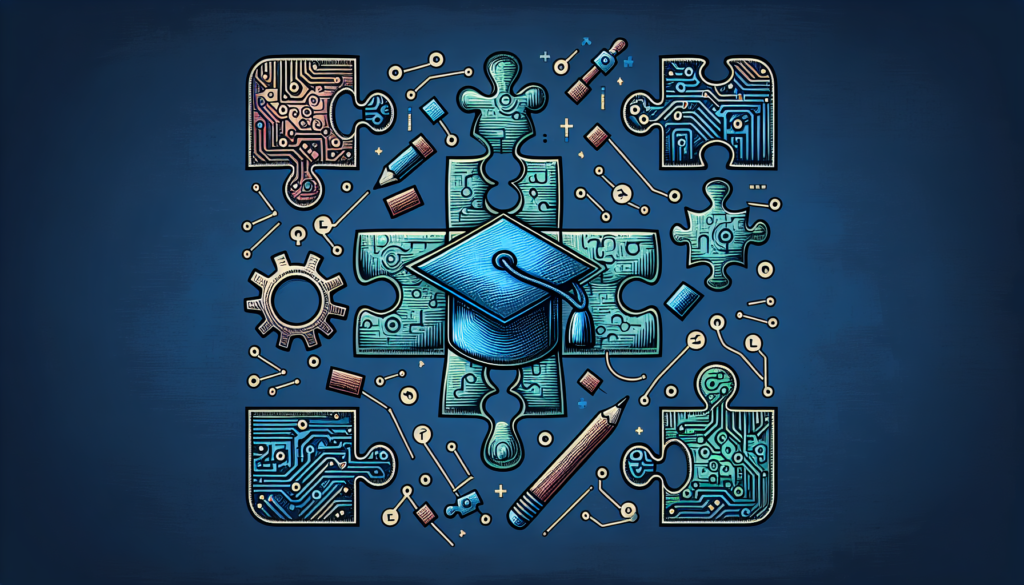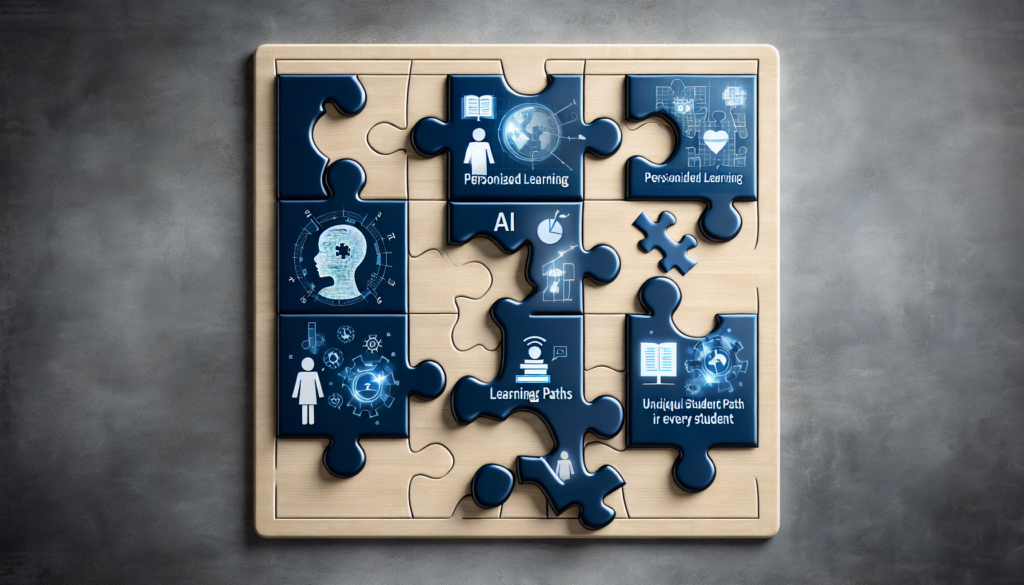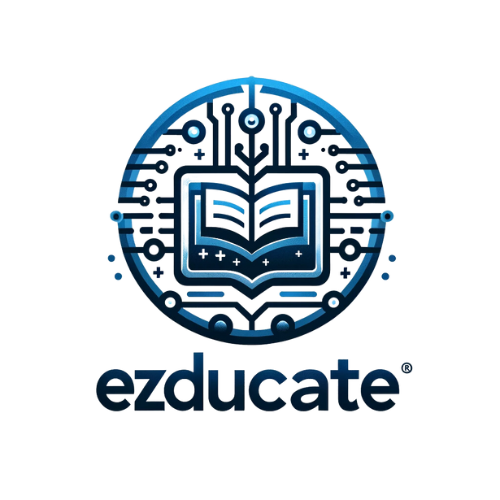In this article, we will explore the fascinating world of artificial intelligence (AI) and its role in addressing the unique needs of individual students. As technology continues to advance, educational apps are becoming increasingly popular, offering customizable learning experiences. But how exactly does the AI behind these apps tailor its responses to cater to the specific requirements of each student? Join us as we uncover the incredible ways in which AI is revolutionizing education and ensuring personalized learning for students everywhere.

Understanding Individual Student Needs
Assessing Student Abilities and Learning Styles
In order to effectively support and cater to the unique needs of each student, it is essential to gain a deep understanding of their abilities and learning styles. AI-powered education platforms utilize various assessment techniques to gather information about a student’s strengths, weaknesses, and overall learning preferences. These assessments may include diagnostic tests, surveys, questionnaires, and interactive activities.
Through these assessments, AI algorithms collect valuable data that enables them to create personalized profiles for each student. This in-depth understanding of individual student abilities and learning styles serves as the foundation for adapting the educational content and recommendations provided by the AI.
Identifying Knowledge Gaps and Weak Areas
One of the key advantages of AI in education is its ability to identify knowledge gaps and weak areas in a student’s understanding. By analyzing data from various sources, such as quizzes, assignments, and previous performance, AI algorithms can pinpoint specific topics or concepts that a student may be struggling with.
This insightful analysis allows the AI to adapt the learning material to address these gaps directly. By presenting targeted exercises, explanations, and resources, the AI ensures that students have the opportunity to reinforce their understanding of challenging areas and build a solid foundation for future learning.
Recognizing Learning Paces
Every student has a unique learning pace, and AI algorithms are designed to recognize and respond to these individual differences. By analyzing data related to a student’s progress, completion rates, and response times, the AI can assess their learning pace and adjust the content delivery accordingly.
For students who grasp concepts quickly, the AI will continuously challenge them with more complex problems and advanced topics. On the other hand, for students who require additional time and support, the AI will provide remedial content and explanations at a more gradual pace. This individualized approach ensures that students are neither overwhelmed nor left behind, promoting optimal learning outcomes for all.
Adapting AI Algorithms
Machine Learning and Data Analysis
One of the core aspects that makes AI in education truly powerful is its ability to learn and improve over time. Through machine learning algorithms and data analysis, AI platforms can continuously refine their understanding of individual student needs.
As students interact with the AI, their responses, progress, and preferences are collected and analyzed. This data is then used to train the AI algorithms, enabling them to make more accurate predictions and recommendations. This iterative process allows the AI to adapt and enhance its ability to meet the unique requirements of each student.
Personalizing Recommendations and Content
AI algorithms excel at personalizing the learning experience for students by providing tailored recommendations and content. Based on the student’s individual profile and learning objectives, the AI can suggest relevant resources, exercises, and activities that align with their interests and learning preferences.
For example, if a student excels in math but struggles with grammar, the AI can prioritize math-related content while providing additional support and resources for improving grammar skills. This level of personalization not only keeps students engaged but also ensures that they are continuously challenged and motivated to learn.
Modifying Difficulty Levels
In order to optimize learning outcomes, AI algorithms are capable of modifying the difficulty levels of the content and assessments provided to students. By accurately assessing a student’s progress and performance, the AI can dynamically adjust the complexity of the material to match their current abilities.
If a student consistently demonstrates mastery in a particular area, the AI can introduce more challenging exercises and concepts to keep them engaged. Conversely, if a student is struggling with a certain topic, the AI can provide additional practice and resources at a more basic level, gradually building their understanding and confidence.
Real-time Feedback and Support
Providing Immediate Responses
One of the key advantages of AI-powered education platforms is the ability to offer immediate feedback and responses to students. As students engage with the AI through quizzes, assignments, or interactive learning activities, the AI can provide instant feedback on their answers and performance.
This real-time feedback helps students identify their mistakes, correct misconceptions, and reinforce their understanding of the material. By receiving immediate responses, students can make timely adjustments to their learning strategies, enabling them to progress more efficiently and effectively.
Offering Customized Explanations
In addition to providing immediate feedback, AI-powered platforms can offer customized explanations to students. If a student answers a question incorrectly or expresses confusion about a certain topic, the AI can generate personalized explanations that address their specific misconceptions or knowledge gaps.
These customized explanations not only help students better understand the material but also foster a sense of personalized support and guidance. By tailoring explanations to individual needs, the AI ensures that students receive the most relevant and impactful feedback to enhance their learning journey.
Guiding Remedial Actions
For students who require additional support, AI platforms can offer guidance and remedial actions to help them overcome challenges. If a student consistently struggles with a particular concept, the AI can provide supplementary resources, tutorials, or interactive activities that target their areas of weakness.
By guiding students towards remedial actions, the AI empowers them to take control of their own learning and actively address their difficulties. This personalized support not only boosts their confidence but also instills valuable problem-solving and self-directed learning skills.

Tracking Progress and Performance
Monitoring Learning Patterns
AI-powered education platforms excel at tracking and monitoring student progress and performance. By analyzing data from various sources, including assignments, quizzes, and interactive activities, the AI can generate insights into a student’s learning patterns.
These insights can highlight trends such as time spent per task, completion rates, and areas of strength or weakness. By closely monitoring learning patterns, the AI can identify potential areas for improvement, adapt the learning experience, and provide targeted support.
Evaluating Accuracy and Speed
In addition to tracking learning patterns, AI algorithms can assess a student’s accuracy and speed in completing tasks. By analyzing response times, error rates, and overall performance, the AI can provide valuable feedback on the student’s efficiency and mastery of the material.
This evaluation of accuracy and speed allows the AI to identify areas where the student may need to slow down and focus on accuracy, or areas where they may need to improve their speed to meet learning objectives. By incorporating these insights into their recommendations and assessments, the AI helps students optimize their learning strategies.
Generating Performance Reports
AI-powered education platforms are capable of generating comprehensive performance reports for students, teachers, and parents. These reports provide a detailed overview of a student’s progress, achievements, and areas for improvement, allowing for informed decision-making and targeted interventions.
Performance reports typically include metrics such as overall grades, completion rates, proficiency levels, and comparative analysis against peers. By providing a holistic view of a student’s academic journey, these reports serve as a valuable tool for tracking progress, setting goals, and celebrating achievements.
Integrating Adaptive Assessments
Continuous Evaluation of Knowledge
AI-powered education platforms are revolutionizing the assessment process by offering continuous evaluation of a student’s knowledge. Instead of relying solely on traditional periodic exams, AI algorithms enable the generation of customized assessments that adapt to the student’s progress and performance.
These adaptive assessments dynamically adjust the difficulty level, question type, and content based on the student’s demonstrated knowledge and learning needs. By continuously evaluating knowledge in real-time, the AI ensures that students are consistently challenged and provided with appropriate learning opportunities.
Dynamic Test Generation
With AI algorithms, education platforms can generate dynamic tests that are tailored to the individual student. These tests may include a combination of multiple-choice questions, fill-in-the-blanks, short answers, and even interactive simulations or scenarios.
By dynamically generating tests, the AI can ensure that each student is presented with a set of questions that aligns with their strengths, weaknesses, and learning goals. This personalized approach to testing not only enhances engagement but also provides a more accurate representation of a student’s knowledge and understanding.
Modifying Question Selection
By leveraging AI algorithms, adaptive assessments can modify the selection of questions based on a student’s performance. If a student answers a question correctly, the AI can present a more challenging follow-up question to further test their understanding. Conversely, if a student struggles with a question, the AI can provide a simpler or more basic question to reinforce key concepts.
This dynamic selection of questions ensures that each student is appropriately challenged and given the opportunity to showcase their knowledge. By tailoring the question selection to individual needs, the AI promotes a personalized and effective learning experience for all students.
Addressing Individual Learning Styles
Visual Learners
AI-powered education platforms recognize and address the needs of visual learners. These platforms incorporate a wide range of visual aids and multimedia resources such as images, videos, infographics, and interactive diagrams. By presenting information in a visual format, the AI ensures that visual learners can absorb and process information more effectively.
Furthermore, AI algorithms can adapt the content delivery to cater to visual learners. For example, the AI might provide visual step-by-step explanations or offer visual exercises that engage visual learners and reinforce their understanding.
Auditory Learners
For auditory learners, AI-powered platforms make use of various strategies to accommodate their learning style. These platforms include audio content such as narrations, podcasts, and recorded lectures to deliver information in a format that resonates with auditory learners.
In addition, AI algorithms can generate personalized voice-based explanations and instructions for auditory learners. By allowing these learners to hear the content, the AI ensures that they can fully engage and comprehend the material.
Kinesthetic Learners
AI in education also caters to the needs of kinesthetic learners, who learn best through hands-on experiences. AI-powered platforms incorporate interactive simulations, virtual experiments, and gamified activities that enable kinesthetic learners to actively engage with the material.
By providing these interactive experiences, the AI allows kinesthetic learners to explore concepts, manipulate objects, and experiment in a virtual environment. This hands-on approach not only enhances their understanding but also promotes deeper learning and retention.
Catering to Diverse Content Needs
Different Subjects and Topics
AI-powered education platforms offer a wide range of subject areas and topics to cater to diverse content needs. These platforms cover various academic disciplines, including mathematics, science, literature, history, languages, and more.
By providing a diverse array of topics, AI algorithms ensure that students have access to comprehensive educational resources that align with their learning goals and interests. Whether they need help with algebra, want to learn about ancient civilizations, or seek to improve their writing skills, AI-powered platforms can accommodate their content needs.
Multimedia and Interactive Resources
In addition to covering various subjects, AI-powered education platforms integrate multimedia and interactive resources to enhance the learning experience. These platforms offer engaging videos, 3D animations, virtual tours, interactive exercises, and gamified activities that capture students’ attention and promote active learning.
By incorporating multimedia and interactive resources, the AI ensures that students have access to a diverse range of learning tools that cater to different learning preferences. These resources make the learning process more engaging, enjoyable, and effective.
Alternate Language Support
AI-powered education platforms can also accommodate students who require alternate language support. These platforms offer multilingual interfaces, translations, and content adaptations to ensure that students can access educational materials in their preferred language.
By providing alternate language support, the AI promotes inclusivity and equity in education, enabling students from different linguistic backgrounds to fully participate in the learning process. This feature allows students to engage with the content, understand instructions, and fully grasp the concepts being taught.
Accounting for Cognitive Abilities
Adapting for Special Needs Students
AI-powered education platforms take into account the cognitive abilities of special needs students. These platforms offer customizable accessibility features such as text-to-speech, speech-to-text, dyslexia-friendly formatting, and visual aids specifically designed to support the needs of these students.
By adapting the content delivery and user interface, the AI ensures that special needs students can engage with the educational materials on their own terms. This personalized support enables them to overcome barriers to learning and actively participate in the educational process.
Tailoring Challenges for Gifted Students
For gifted students who require additional challenges, AI algorithms can tailor the content delivery to meet their advanced abilities. By identifying their areas of strength and providing more complex exercises, the AI ensures that gifted students are continuously engaged and pushed to their full potential.
In addition, AI-powered platforms can offer enrichment resources, advanced topics, and personalized recommendations that align with the interests and abilities of gifted students. This tailored approach to challenging gifted students promotes their intellectual growth and fosters a love for learning.
Accommodating Learning Disabilities
AI in education also accommodates students with learning disabilities by offering specialized support and adaptations. These platforms can provide additional scaffolding, step-by-step explanations, or alternative formats to address the specific needs of students with learning disabilities.
By accommodating learning disabilities, the AI ensures that these students can access and comprehend the educational materials with ease. This personalized support promotes inclusivity, empowers students with learning disabilities, and encourages their active participation in the learning process.
Promoting Engagement and Motivation
Gamification and Rewards Systems
AI-powered education platforms make use of gamification and rewards systems to promote engagement and motivation. By incorporating elements such as points, badges, leaderboards, and virtual rewards, the AI creates a sense of achievement and competition that drives students to actively participate and excel.
These gamified features transform the learning experience into an enjoyable and immersive journey, encouraging students to consistently strive for improvement and mastery. By setting goals, tracking progress, and celebrating achievements, the AI fosters motivation and a positive attitude towards learning.
Interactive and Dynamic Interfaces
In order to keep students engaged, AI-powered platforms feature interactive and dynamic interfaces. These interfaces allow students to actively interact with the content, providing opportunities for exploration, experimentation, and discovery.
Through interactive interfaces, the AI promotes active learning and hands-on experiences that enhance comprehension and retention. Students can manipulate objects, solve puzzles, and engage in simulations, creating a dynamic learning environment that captures their attention and promotes deeper understanding.
Progress Tracking and Achievements
AI-powered education platforms track and display students’ progress and achievements to foster motivation and a sense of accomplishment. Students can view their completion rates, scores, and advancements, providing them with a visual representation of their growth and progress.
By tracking progress, the AI allows students to set goals, monitor their improvement, and celebrate their achievements. This feedback loop not only motivates students to continue their learning journey but also provides them with a tangible sense of accomplishment that boosts their self-confidence and engagement.
Ethical Considerations
Safeguarding Student Privacy and Data
As AI becomes more integrated into education, it is crucial to prioritize the protection of student privacy and data. AI-powered education platforms follow strict protocols and privacy regulations to ensure that student information remains confidential and secure.
These platforms prioritize data encryption, secure storage, and permission-based access to protect sensitive student data from unauthorized disclosure or misuse. Additionally, AI algorithms are designed to anonymize and aggregate data when generating insights and recommendations, further safeguarding student privacy.
Avoiding Bias and Discrimination
AI algorithms in education must be developed with a commitment to fairness, diversity, and inclusion. It is essential to ensure that the algorithms do not perpetuate biases or discriminate against certain groups of students.
To address this concern, AI-powered platforms undergo rigorous testing and validation processes to identify and eliminate potential biases. By continuously monitoring the performance and impact of the AI algorithms, developers can mitigate the risk of bias, promote fairness, and create a learning environment that supports all students.
Ensuring Transparent Algorithms
Transparency is a crucial aspect of implementing AI in education. The algorithms used by AI-powered platforms should be transparent and understandable, allowing teachers, students, and parents to comprehend how the AI generates recommendations and assessments.
By providing transparency, AI platforms promote trust and accountability. Students can understand the basis for the feedback provided by the AI, and teachers and parents can confidently rely on the AI’s recommendations and insights to make informed decisions regarding a student’s learning journey.
In conclusion, AI in education offers immense potential for addressing individual student needs and enhancing the learning experience. Through assessments, adaptive algorithms, real-time feedback, and personalized recommendations, AI-powered platforms can tailor the educational content to match each student’s unique abilities, learning styles, and pace. By tracking progress, integrating adaptive assessments, and addressing cognitive abilities, AI promotes inclusive and effective education. With consideration for engagement, motivation, and ethical guidelines, AI can truly revolutionize the way we educate and empower individual students.




